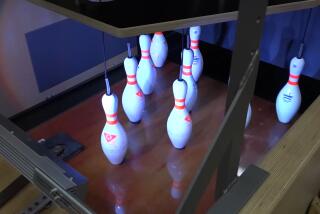Marketers Display Nifty Stick-Handling
- Share via
The grumbling that started early in the season has gathered all the momentum of a 100-mile-an-hour slap shot.
The Los Angeles Kings shelled out $57,000 more this year. The Minnesota Wild swallowed an additional $75,000. And the Anaheim Mighty Ducks, who crushed the Wild on their run for the Stanley Cup, already have spent $100,000 more -- and counting.
Add yet another financial headache for the National Hockey League, which has already seen two of its franchises file for bankruptcy this year while others hemorrhage red ink: the soaring cost of hockey sticks.
NHL teams are feeling the economic hangover from a technological binge that has transformed a humble piece of sports equipment into a status symbol and marketing marvel.
What were simple wooden sticks that retailed for $30 are now designer creations that cost more than $170 and promise the ultimate in “flex points,” shaft torque and Space Age metal alloys.
Some question whether the sticks give players a quicker, more powerful shot, as advertised. In a league that must pinch pennies to survive, however, there are more practical concerns, such as whether sticks crack too easily and cost too much to replace. A recently launched NHL study promises to examine stick breakage.
“The stick costs three times as much as a wood stick, and the problem is the durability isn’t what it should be,” said the Mighty Ducks’ equipment manager, Mark O’Neill. “If you’re paying that much for a stick, you’d think it would last longer.”
A lot has changed in the world of hockey sticks. Sales of wood sticks, once the only game in town, now represent just a third of the $123-million North American market, industry figures show. Sales of composite metal models, such as the ones most NHL players use, have skyrocketed 500% since last year.
The story behind this shift serves as a parable for all of sports marketing, where the perceived advantage of using a certain shoe, racquet, club, glove or bat is as important as its actual performance. Time and again, a company reaps a financial benefit by developing a marginally better product and putting it in the hands of a world-class pro.
The trick for today’s hockey stick manufacturer has been trying to strike a balance between creating an alloy stick light enough to give the velocity needed to rocket off a shot, yet strong enough to withstand the slashing that comes with the sport’s brutal play. By league regulation, however, composite sticks must break under pressure as easily as wood -- to protect players from serious injury.
Until the early 1980s, the biggest innovation to the traditional wood-and-fiberglass hockey sticks was curving the blade. And when those blades broke, players had little alternative except to tape them up or throw out the entire stick.
That changed when a Van Nuys-based sports-equipment manufacturer known for its metal bats cast its eye on the stick market in 1981.
Restless for a new arena in which to flex its metallurgical muscle, Easton Sports Inc. devised a two-piece stick that promised to save players money with a hollow aluminum shaft fitted with replaceable wooden blades.
The stick received a lukewarm welcome in a marketplace that was used to the feel of a traditional stick. Easton turned to hockey great Wayne Gretzky for help after he was traded to the Los Angeles Kings. It signed him to an endorsement deal that put an Easton stick in his hand and kept it there, through his record-setting 802nd goal in 1994.
“Strategically, we realized that if we were going to be a hockey company, we had to get a little more exposure,” said Ned Goldsmith, Easton’s vice president for hockey. “So we signed the most famous hockey player in the world to endorse the product. That put us on the map.”
Easton’s sales jumped 30%, and the company had the makings of the star-based marketing formula that has helped it dominate the industry since 2000, when it introduced its first one-piece composite model, the Synergy. The stick weighed a third less than wood, was made of Kevlar and carbon and was engineered to have a flex point lower on the shaft than the traditional stick that helps disperse greater energy to the blade.
The privately held company selected a few NHL stars to carry its sticks, and eyeballs popped when one, Maple Leaf center Mats Sundin, scored with wicked slap shots. Other players soon began clamoring for the sticks. By Easton’s count, 57% of the NHL now uses the Synergy or its latest model, the Si-Core.
“You’re using a stick with more flex in it, a little whippier,” said Detroit Red Wings captain Steve Yzerman, also an Easton-sponsored athlete. “It flexes just like a slingshot. It’s the same principle.”
Consumers flocked to the stick too, wreaking havoc on a tradition-bound industry in which Nova Scotia Indians once hand-carved sticks from tree roots.
*
Industry Changes
In recent years, old-line manufacturers have been forced to scale back lumber operations while scrambling to come up with their own one-piece composites. Sticks that were once made in frigid Quebec are now being pressed out of machines in Mexico and the Far East. One company, Bending Branches in Wisconsin, announced this year that it was quitting the wooden stick business.
Whether the new sticks are worth all the grief, much less the price, is open to debate.
Easton executives acknowledge they don’t have “anything scientific to fall back on” in explaining the Synergy’s performance. But they say the lighter composite sticks are inherently better because, unlike wood, they don’t degrade with use or vary from their precise dimensions because of the fiber.
“The reason why we know it’s the best stick in the world is that the best players in the world have told us that,” President Anthony M. Palma said. “That’s something no lab tests can tell you.”
Researchers at another stick manufacturer, Quebec-based the Hockey Co., say tests using a robot show their CCM Vector Model 110 shoots a puck 10% faster than wood. That translates into a potential improvement of 3% to 5% with real players, said research director Stephen Murphy.
“Think about it,” said Murphy, whose 412-page doctoral dissertation described the physics of a slap shot. “Certainly, the reaction time of the goalie has been reduced and you have the potential to score more goals.”
*
Data Cast Doubt
It hasn’t turned out that way. Despite the influx of composite sticks, NHL statistics show that the average number of goals per game continues to decline, to 5.3 -- among the lowest in five decades.
The NHL’s reigning slap-shot champion, Al MacInnis of the St. Louis Blues, brandishes wood, as do more than 10% of the players in the league.
And when a recent McGill University project in Montreal studied how players of varying skill levels performed with different sticks, it concluded that everyone shot the puck just as hard with wood as with composite sticks costing five times as much.
“In some cases we just used cheap wood sticks, the cheapest we had, and they had the same shot velocity as the fancy ones,” said David Pearsall, who has a doctorate in kinesiology and oversaw the study funded by Greenland, N.H.-based Bauer Nike Hockey Inc. and the Canadian government.
So why the belief that one-piece composites turn an average player into a scoring machine? “Marketing,” Pearsall said.
That point of view isn’t lost on legions of hockey moms and dads already under the gun to pay hundreds of dollars for ice time, travel and other equipment each season.
A few refuse to pay the higher price despite the peer pressure on their children to get the latest gear, said Vince Spinosa, who manages the pro shop at the HealthSouth Training Center in El Segundo.
“You get those people who say, ‘There’s no way I’m spending $150 on a hockey stick,’ ” he said.
Many more are like Santa Clarita hockey dad Chuck Wohlfeiler, who said he’s not convinced the $150 model he recently bought for his 14-year-old daughter, Alyssa, is going to do that much more for her game.
“If it’s going to make her play better, even if it’s psychological, maybe it’s not that big in the scheme of things,” said Wohlfeiler, an LAPD officer. “It’s kind of like the cost of gasoline. You complain about it but you know you have to do it.”
At hockey’s highest level, equipment managers are complaining plenty. Their budgets are soaring, as the bills are coming due for all the players switching over in the last two years to the more expensive composites.
The league doesn’t keep track of how many of the tens of thousands of sticks used each year are broken during practices and games. The Ducks, for instance, order about 14 dozen sticks for each player a year, said equipment manager O’Neill.
Some are taking strong measures to save money. O’Neill, for example, started hoarding sticks for part of the season. The Ducks and other teams have gone so far as to bar their minor league franchises from using the one-piece composites.
Minnesota Wild equipment manager Tony Da Costa agrees the costs are a problem. “Every team’s talking. Every team’s dealing with the numbers,” Da Costa said. His team’s budget tells the tale: It shot up from $150,000 to $225,000 a year.
The pique has been compounded by a series of high-profile stick-breaking incidents during the playoffs, when players are especially aggressive against the boards and slash at their opponents’ sticks. In one playoff game, the Ducks swiped the puck and scored when a Wild player’s stick snapped in two as he was taking a slap shot from the blue line.
Complaints have put Easton, in particular, on the defensive. Executives say the company is being unfairly singled out over claims that its Synergy is breaking. Like most companies, Easton declines to report its actual breakage figures but says they have improved since the stick was introduced, and recent tests show no defects in construction. It also stresses that consumers get a 30-day warranty with their sticks.
Still, NHL officials say they will be taking a closer look at breakage rates. The league already had plans put in motion to test stick durability for informational purposes, and the recent bad publicity gives “the research ... more meaning,” said Dave Dryden, chairman of the player safety panel of the NHL.
Dryden said the NHL asked nine manufacturers to ship their sticks to the University of Calgary in Canada for tests, which probably will be expanded to examine claims that one-piece composites can increase shot velocity as much as 10%.
He, for one, is suspicious.
“I don’t think the data supports that claim,” he said. “It’s very dubious.”
What isn’t in doubt, though, is how companies such as Easton can push consumers’ buttons by making sure their newest items are associated with the athletic prowess of the pros. Case in point: Dany Heatley of the Atlanta Thrashers.
Heatley started using Easton’s new Synergy Si-Core in time for the NHL All-Star game in January, months before the stick rolled out for retail.
Then lightning struck. Heatley scored four goals, tying the All-Star record.
Easton executives say they’re now running their Tijuana factory 24 hours a day to meet demand for the $169 stick, which began shipping off to pro shops this month. The hockey world, it seems, can’t wait to get its hands on a stick with the latest twist: a gel-injected blade designed to give it the stick-handling feel players say they want.
The feel of old-fashioned wood.
More to Read
Go beyond the scoreboard
Get the latest on L.A.'s teams in the daily Sports Report newsletter.
You may occasionally receive promotional content from the Los Angeles Times.






